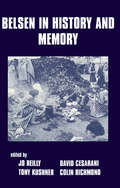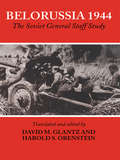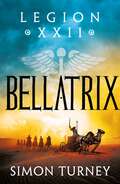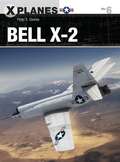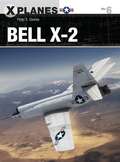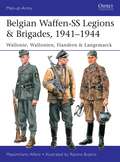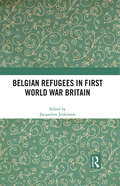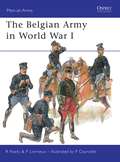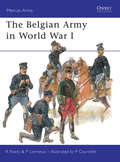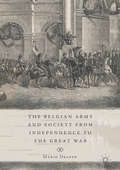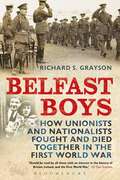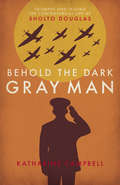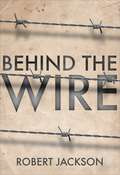- Table View
- List View
Belsen in History and Memory
by David Cesarani Tony Kushner Jo Reilly Colin RichmondDrawing on documentary and oral sources in Yiddish, Hebrew, German, Dutch and French, this book challenges many sterotypes about Belsen, and reinstates the groups hitherto marginalized or ignored in accounts of the camp and its liberation.
Belsen in History and Memory
by Jo Reilly David Cesarani Tony Kushner Colin RichmondDrawing on documentary and oral sources in Yiddish, Hebrew, German, Dutch and French, this book challenges many sterotypes about Belsen, and reinstates the groups hitherto marginalized or ignored in accounts of the camp and its liberation.
Belorussia 1944: The Soviet General Staff Study (Soviet (Russian) Study of War)
by David GlantzA new edited translation of the Soviet Staff study of the Red Army's Belorussian operation in the summer of 1944, which was unprecedented in terms of its scale, scope and strategic consequences. The Soviet Stavka had planned a campaign consisting of a series of massive operations spanning the entire Soviet-German front. Four powerful fronts (army groups) operated under close Stavka (high command) control. Over 1.8 million troops acomplished a feat unique in the history of the Red Army: the defeat and dismemberment of an entire German army group. This book is a translation of the Soviet General Staff Study No 18, a work originally classified as 'secret' and intended to educate Soviet commanders and staff officers. The operation is presented from the Soviet perspective, in the words of the individuals who planned and orchestrated the plans. A map supplement, including terrain maps, is provided to illustrate the flow of the operation in greater detail.
Belorussia 1944: The Soviet General Staff Study (Soviet (Russian) Study of War #No. 12)
by David M. Glantz Harold S. OrensteinA new edited translation of the Soviet Staff study of the Red Army's Belorussian operation in the summer of 1944, which was unprecedented in terms of its scale, scope and strategic consequences. The Soviet Stavka had planned a campaign consisting of a series of massive operations spanning the entire Soviet-German front. Four powerful fronts (army groups) operated under close Stavka (high command) control. Over 1.8 million troops acomplished a feat unique in the history of the Red Army: the defeat and dismemberment of an entire German army group. This book is a translation of the Soviet General Staff Study No 18, a work originally classified as 'secret' and intended to educate Soviet commanders and staff officers. The operation is presented from the Soviet perspective, in the words of the individuals who planned and orchestrated the plans. A map supplement, including terrain maps, is provided to illustrate the flow of the operation in greater detail.
Belonging to the Nation: Inclusion And Exclusion In The Polish-german Borderlands, 1939-1951
by John J. KulczyckiIn 1939 Nazis identified Polish citizens of German origin and granted them legal status as ethnic Germans of the Reich. After the war Poland did just the opposite: searched out Germans of Polish origin and offered them Polish citizenship. John Kulczycki’s account underscores the processes of inclusion and exclusion that mold national communities.
Bellatrix (Legion XXII #2)
by Simon TurneyWarrior and combat medic of the Twenty Second Legion, Titus Cervianus, must fight the armies of the fabled Warrior Queen in this blistering new Roman adventure from Simon Turney.Egypt, 25 BC. Titus Cervianus is no ordinary soldier. And the Twenty Second is no ordinary legion. Formed from the personal guard of a conquered king, the Twenty Second's ways are strange to soldiers of the Empire - yet the legion has proved itself in the blistering heat of the desert. Cervianus and his comrades march into the unknown as he and the Twenty Second Legion contend with the armies of the Bellatrix: the Warrior Queen of Kush. The Kushites and the Egyptians are united against the Roman presence in their lands – but there are complex political and military forces at work. Deep in the deserts, Cervianus and his comrades must brace themselves for a furious onslaught as they take on the might of the Bellatrix.Reviews for Simon Turney's Legion XXII series'If you want gritty and utterly authentic edge of the seat Roman action, you should be reading Simon Turney.' Anthony Riches'Brings a whole new dimension to the genre... Recommended.' Historical Novel Society'A blistering desert epic, brimming with tension, mystery and adventure!' Gordon Doherty Reviews for Simon Turney'A page turner from beginning to end... A damn fine read.' Ben Kane'First-rate Roman fiction.' Matthew Harffy
Bell X-2 (X-Planes)
by Adam Tooby Peter E. DaviesEven before the spectacular success of its X-1 rocket-powered aircraft in breaking the 'sound barrier', the adventurous Bell Aircraft Corporation was already pushing ahead with a parallel project to build a second aircraft capable of far higher speeds. The X-2 (or Model 52) explored the equally uncertain technology of swept-back wings. Now common in modern conventional fighter aircraft, the Bell X-2 was revolutionary in using this type of airframe to probe Mach 3 and research the effects of extreme aerodynamic friction heat on airframes. Although both X-2s were destroyed in crashes after only 20 flights, killing two test pilots, the knowledge gained from the programme was invaluable in developing aircraft that could safely fly at such speeds. Using stunning artwork and historical photographs, this is the story of the plane that ultimately made the Lockheed Blackbird and Concorde possible.
Bell X-2 (X-Planes #6)
by Adam Tooby Peter E. DaviesEven before the spectacular success of its X-1 rocket-powered aircraft in breaking the 'sound barrier', the adventurous Bell Aircraft Corporation was already pushing ahead with a parallel project to build a second aircraft capable of far higher speeds. The X-2 (or Model 52) explored the equally uncertain technology of swept-back wings. Now common in modern conventional fighter aircraft, the Bell X-2 was revolutionary in using this type of airframe to probe Mach 3 and research the effects of extreme aerodynamic friction heat on airframes. Although both X-2s were destroyed in crashes after only 20 flights, killing two test pilots, the knowledge gained from the programme was invaluable in developing aircraft that could safely fly at such speeds. Using stunning artwork and historical photographs, this is the story of the plane that ultimately made the Lockheed Blackbird and Concorde possible.
Bell X-1 (X-Planes #1)
by Jim Laurier Gareth Hector Peter E. DaviesIn 1947, no one knew if it was possible to break the 'sound barrier'. The Bell X-1 was the tiny, rocket-powered craft that finally broke it. It was the result of innovative designers and engineers turning their attention from the pioneering jets of World War II to a new task – an aircraft designed purely to fly faster than sound. Legendary pilots rallied to the cause, with World War II ace Chuck Yeager piloting the X-1 when it finally achieved supersonic flight in 1947, the first manned craft to reach such speeds. With historical photographs and meticulously researched digital art, Peter Davies traces the whole career of the pioneering Bell X-1, from its early development through to the influence it had on military and civilian jets in the second half of the 20th century.
Bell X-1 (X-Planes #1)
by Jim Laurier Gareth Hector Peter E. DaviesIn 1947, no one knew if it was possible to break the 'sound barrier'. The Bell X-1 was the tiny, rocket-powered craft that finally broke it. It was the result of innovative designers and engineers turning their attention from the pioneering jets of World War II to a new task – an aircraft designed purely to fly faster than sound. Legendary pilots rallied to the cause, with World War II ace Chuck Yeager piloting the X-1 when it finally achieved supersonic flight in 1947, the first manned craft to reach such speeds. With historical photographs and meticulously researched digital art, Peter Davies traces the whole career of the pioneering Bell X-1, from its early development through to the influence it had on military and civilian jets in the second half of the 20th century.
Belgian Waffen-SS Legions & Brigades, 1941–1944: Wallonie, Wallonien, Flandern & Langemarck (Men-at-Arms)
by Massimiliano AfieroFrom the German occupation of Belgium in May 1940, Flemish recruits from northern Belgium – considered by the Nazis to be 'Germanic' – were accepted individually into Waffen-SS units. From Hitler's invasion of the USSR in June 1941, additional recruits from the French-speaking south (Wallonia) were drafted. Both communities formed volunteer 'Legions', to fight (according to Goebbels' propaganda machine) 'for European civilization against the Bolshevik threat'; these were a Flemish Legion in the Waffen-SS and a Walloon Legion in the German Army. Both served on the Russian Front in 1942-43; the Walloon Legion was then also transferred into the Waffen-SS, and the decorated Walloon officer Leon Degrelle became a publicized 'poster boy' for foreign SS volunteers. Both Legions were then redesignated as SS Assault Brigades, and thereafter saw extremely hard fighting in the Ukraine and on the Baltic front. In autumn 1944, their survivors were withdrawn from the front and incorporated into two new understrength SS Divisions, 27. 'Langemarck' and 28. 'Wallonien'.This new account, featuring detailed colour plates of uniform and insignia, recounts the battle history of the French and Flemish-speaking Belgian SS, up to their final transformation into full divisions in the winter of 1944/45.
Belgian Waffen-SS Legions & Brigades, 1941–1944: Wallonie, Wallonien, Flandern & Langemarck (Men-at-Arms)
by Massimiliano AfieroFrom the German occupation of Belgium in May 1940, Flemish recruits from northern Belgium – considered by the Nazis to be 'Germanic' – were accepted individually into Waffen-SS units. From Hitler's invasion of the USSR in June 1941, additional recruits from the French-speaking south (Wallonia) were drafted. Both communities formed volunteer 'Legions', to fight (according to Goebbels' propaganda machine) 'for European civilization against the Bolshevik threat'; these were a Flemish Legion in the Waffen-SS and a Walloon Legion in the German Army. Both served on the Russian Front in 1942-43; the Walloon Legion was then also transferred into the Waffen-SS, and the decorated Walloon officer Leon Degrelle became a publicized 'poster boy' for foreign SS volunteers. Both Legions were then redesignated as SS Assault Brigades, and thereafter saw extremely hard fighting in the Ukraine and on the Baltic front. In autumn 1944, their survivors were withdrawn from the front and incorporated into two new understrength SS Divisions, 27. 'Langemarck' and 28. 'Wallonien'.This new account, featuring detailed colour plates of uniform and insignia, recounts the battle history of the French and Flemish-speaking Belgian SS, up to their final transformation into full divisions in the winter of 1944/45.
Belgian Refugees in First World War Britain
by Jacqueline JenkinsonAround 250,000 Belgian refugees who fled the German invasion spent the First World War in Britain – the largest refugee presence Britain has ever witnessed. Welcomed in a wave of humanitarian sympathy for ‘Poor Little Belgium’, within a few months Belgian exiles were pushed off the front pages of newspapers by the news of direct British involvement in the war. Following rapid repatriation at British government expense in late 1918 and 1919 Belgian refugees were soon lost from public memory with few memorials or markers of their mass presence.Reactions to Belgian refugees discussed in this book include the mixed responses of local populations to the refugee presence, which ranged from extensive charitable efforts to public and trade union protests aimed at protecting local jobs and housing. This book also explores the roles of central and local government agencies which supported and employed Belgian refugees en masse yet also used them as a propaganda tool to publicise German outrages against civilians to encourage support for the Allied war effort. This book covers responses to Belgian refugees in England, Scotland, Ireland and Wales in a Home Front wartime episode which generated intense public interest and charitable and government action. This book was originally published as a special issue of Immigrants and Minorities: Historical Studies in Ethnicity, Migration and Diaspora.
Belgian Refugees in First World War Britain
by Jacqueline JenkinsonAround 250,000 Belgian refugees who fled the German invasion spent the First World War in Britain – the largest refugee presence Britain has ever witnessed. Welcomed in a wave of humanitarian sympathy for ‘Poor Little Belgium’, within a few months Belgian exiles were pushed off the front pages of newspapers by the news of direct British involvement in the war. Following rapid repatriation at British government expense in late 1918 and 1919 Belgian refugees were soon lost from public memory with few memorials or markers of their mass presence.Reactions to Belgian refugees discussed in this book include the mixed responses of local populations to the refugee presence, which ranged from extensive charitable efforts to public and trade union protests aimed at protecting local jobs and housing. This book also explores the roles of central and local government agencies which supported and employed Belgian refugees en masse yet also used them as a propaganda tool to publicise German outrages against civilians to encourage support for the Allied war effort. This book covers responses to Belgian refugees in England, Scotland, Ireland and Wales in a Home Front wartime episode which generated intense public interest and charitable and government action. This book was originally published as a special issue of Immigrants and Minorities: Historical Studies in Ethnicity, Migration and Diaspora.
The Belgian Army in World War I (Men-at-Arms)
by Patrice Courcelle Ronald Pawly Pierre LierneuxWhile small in numbers, the Belgian Army played a vital role in World War 1 that is often overlooked. Germany's invasion of neutral Belgium, which led Britain to declare war in August 1914, should have been swift and fierce yet the unexpected heroic defence, against great odds, of Belgian fortresses, frustrated the German Schlieffen Plan for a thrust to Paris and a lightning victory. The plucky Belgian resistance proved successful in buying time for French and British troops to mobilize and report to the front, where the Belgians would then go on to fight, stubbornly defending the northern end of the Allied trench line for the rest of the war. Discover the story of this determined Army, from their organization and commanders, to their uniforms and equipment. The only main combatant army of World War I not previously covered by Osprey, this volume will be an important addition to any enthusiast's collection, accompanied by detailed artwork and archive photographs.
The Belgian Army in World War I (Men-at-Arms #452)
by Patrice Courcelle Ronald Pawly Pierre LierneuxWhile small in numbers, the Belgian Army played a vital role in World War 1 that is often overlooked. Germany's invasion of neutral Belgium, which led Britain to declare war in August 1914, should have been swift and fierce yet the unexpected heroic defence, against great odds, of Belgian fortresses, frustrated the German Schlieffen Plan for a thrust to Paris and a lightning victory. The plucky Belgian resistance proved successful in buying time for French and British troops to mobilize and report to the front, where the Belgians would then go on to fight, stubbornly defending the northern end of the Allied trench line for the rest of the war. Discover the story of this determined Army, from their organization and commanders, to their uniforms and equipment. The only main combatant army of World War I not previously covered by Osprey, this volume will be an important addition to any enthusiast's collection, accompanied by detailed artwork and archive photographs.
The Belgian Army and Society from Independence to the Great War
by Mario DraperThis book explores Belgian state-building through the prism of its army from independence to the First World War. It argues that party-politics, which often ran along geographical, linguistic, and religious lines, prevented both Flemings and Walloons from reconciling their regional identities into a unified concept of Belgian nationalism. Equally, it obstructed the army from satisfactorily preparing to uphold Belgium’s imposed neutrality before 1914. Situated uneasily between the two powerhouses of nineteenth-century Europe, Belgium offers a unique insight into the concepts of citizenship and militarisation in a divided society in the era of fervent nationalism. By examining the composition, experience, and image of the army’s officer corps and rank and file, as well as those of the auxiliary forces, this book shows that although military and civilian society often stood aloof from one another, the army, as a national institution, offered a fleeting glimpse into the dichotomy that was pre-war Belgium.
The Belgian Army and Society from Independence to the Great War
by Mario DraperThis book explores Belgian state-building through the prism of its army from independence to the First World War. It argues that party-politics, which often ran along geographical, linguistic, and religious lines, prevented both Flemings and Walloons from reconciling their regional identities into a unified concept of Belgian nationalism. Equally, it obstructed the army from satisfactorily preparing to uphold Belgium’s imposed neutrality before 1914. Situated uneasily between the two powerhouses of nineteenth-century Europe, Belgium offers a unique insight into the concepts of citizenship and militarisation in a divided society in the era of fervent nationalism. By examining the composition, experience, and image of the army’s officer corps and rank and file, as well as those of the auxiliary forces, this book shows that although military and civilian society often stood aloof from one another, the army, as a national institution, offered a fleeting glimpse into the dichotomy that was pre-war Belgium.
Belfast Boys: How Unionists and Nationalists Fought and Died Together in the First World War
by Richard S. GraysonThis is the story of men from either side of West Belfast's sectarian divide during the Great War. Richard S. Grayson follows the volunteers of the 36th and 16th divisions who fought on the Somme and side-by-side at Messines, recovering the forgotten West Belfast men throughout the armed forces, from the retreat at Mons to the defeat of Germany and life post-war. In so doing, he tells a new story which challenges popular perceptions of the war and explains why remembrance remains so controversial in Belfast today.
Belfast Boys: How Unionists and Nationalists Fought and Died Together in the First World War
by Richard S. GraysonThis is the story of men from either side of West Belfast's sectarian divide during the Great War. Richard S. Grayson follows the volunteers of the 36th and 16th divisions who fought on the Somme and side-by-side at Messines, recovering the forgotten West Belfast men throughout the armed forces, from the retreat at Mons to the defeat of Germany and life post-war. In so doing, he tells a new story which challenges popular perceptions of the war and explains why remembrance remains so controversial in Belfast today.
Behold the Dark Gray Man: Triumphs and Trauma: The Controversial Life of Sholto Douglas
by Katherine CampbellKatharine Campbell’s father Sholto Douglas was the hero of her childhood, an unconventional senior commander in the Royal Air Force described as ‘a gloriously contentious character’. Following childhood abandonment and poverty, Sholto rose through the ranks of the fledgling RAF in the First World War before taking on a crucial role in the Second as head of Fighter Command and going on to serve as Military Governor in Germany in the war’s devastating aftermath.But when Katharine was five years old, he began to be stolen away by strange night-time wanderings and daytime distress – including vivid flashbacks to his time signing death warrants in post-war Germany. The doctors called it dementia, but decades later, Katharine started researching her father’s story and realised that she had observed the undiagnosed consequences of post-traumatic stress disorder.PTSD is a hot topic today. We’re aware of the front-line soldier suffering from ‘shell-shock’ – but what about the senior officer giving the orders, who may be carrying hidden wounds accumulated over many years? We don’t expect our military leaders to have PTSD, nor is it something they often recognise or acknowledge in themselves, yet this secret burden likely affects a surprising number of those making important tactical decisions. A thought-provoking insight into the damage done by military conflict, Behold the Dark Gray Man is the story of a daughter’s search to understand the impact of war upon one of its most charismatic senior commanders.
Behind the Wire: Prisoners of War 1914-18 (General Military Ser.)
by Robert JacksonBefore World War I the Geneva Convention established 'rules' for the treatment of Prisoners of War, and all belligerents during the war were to adhere to them; however, the rules were in many ways ambiguous and as a result, the treatment of POWs varied from nation to nation. In this book Robert Jackson examines the treatment POWs received from both sides of the lines, from British airmen shot down to German POWs and from American escapes to the armistice.
Behind the Wire: Prisoners of War 1914-18
by Robert JacksonBefore World War I the Geneva Convention established 'rules' for the treatment of Prisoners of War, and all belligerents during the war were to adhere to them; however, the rules were in many ways ambiguous and as a result, the treatment of POWs varied from nation to nation. In this book Robert Jackson examines the treatment POWs received from both sides of the lines, from British airmen shot down to German POWs and from American escapes to the armistice.
Behind the Enigma: The Authorised History of GCHQ, Britain’s Secret Cyber-Intelligence Agency
by John FerrisYou know about MI5. You know about MI6.Now uncover the mystery behind Britain's most secretive intelligence agency, in the first ever authorised history of GCHQ. For a hundred years, GCHQ – Government Communications Headquarters – has been at the forefront of innovation in national security and British secret statecraft. Famed for its codebreaking achievements during the Second World War, and essential to the Allied victory, GCHQ also held a critical role in both the Falklands War and Cold War. Today, amidst the growing threats of terrorism and online crime, GCHQ continues to be the UK's leading intelligence, security and cyber agency, and a powerful tool of the British state. Based on unprecedented access to classified archives, Behind the Enigma is the first book to authoritatively tell the entire history of this most unique and enigmatic of organisations – and peer into its future at the heart of the nation's security.
Behind the Enigma: The Authorised History of GCHQ, Britain’s Secret Cyber-Intelligence Agency
by John Ferris'Fascinating … This monumental work completes the authorised picture of a century of British intelligence' BEN MACINTYRE, THE TIMES '[A] revelatory look at the world of GCHQ … There is much in the book that illuminates' Mark Urban, Sunday Times You know about MI5. You know about MI6.Now uncover the mystery behind Britain's most secretive intelligence agency, in the first ever authorised history of GCHQ. For a hundred years, GCHQ – Government Communications Headquarters – has been at the forefront of innovation in national security and British secret statecraft. Famed for its codebreaking achievements during the Second World War, and essential to the Allied victory, GCHQ also held a critical role in both the Falklands Conflict and Cold War. Today, amidst the growing threats of terrorism and online crime, GCHQ continues to be the UK's leading intelligence, security and cyber agency, and a powerful tool of the British state. Based on unprecedented access to classified archives, Behind the Enigma is the first book to authoritatively tell the entire history of this most unique and enigmatic of organisations – and peer into its future at the heart of the nation's security.
